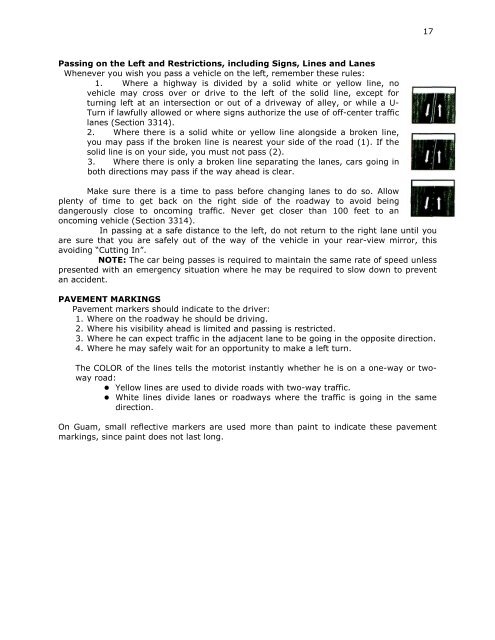Territory of Guam Driver's Handbook - Tumon.com
Territory of Guam Driver's Handbook - Tumon.com
Territory of Guam Driver's Handbook - Tumon.com
Create successful ePaper yourself
Turn your PDF publications into a flip-book with our unique Google optimized e-Paper software.
Passing on the Left and Restrictions, including Signs, Lines and Lanes<br />
Whenever you wish you pass a vehicle on the left, remember these rules:<br />
1. Where a highway is divided by a solid white or yellow line, no<br />
vehicle may cross over or drive to the left <strong>of</strong> the solid line, except for<br />
turning left at an intersection or out <strong>of</strong> a driveway <strong>of</strong> alley, or while a U-<br />
Turn if lawfully allowed or where signs authorize the use <strong>of</strong> <strong>of</strong>f-center traffic<br />
lanes (Section 3314).<br />
2. Where there is a solid white or yellow line alongside a broken line,<br />
you may pass if the broken line is nearest your side <strong>of</strong> the road (1). If the<br />
solid line is on your side, you must not pass (2).<br />
3. Where there is only a broken line separating the lanes, cars going in<br />
both directions may pass if the way ahead is clear.<br />
Make sure there is a time to pass before changing lanes to do so. Allow<br />
plenty <strong>of</strong> time to get back on the right side <strong>of</strong> the roadway to avoid being<br />
dangerously close to on<strong>com</strong>ing traffic. Never get closer than 100 feet to an<br />
on<strong>com</strong>ing vehicle (Section 3314).<br />
In passing at a safe distance to the left, do not return to the right lane until you<br />
are sure that you are safely out <strong>of</strong> the way <strong>of</strong> the vehicle in your rear-view mirror, this<br />
avoiding “Cutting In”.<br />
NOTE: The car being passes is required to maintain the same rate <strong>of</strong> speed unless<br />
presented with an emergency situation where he may be required to slow down to prevent<br />
an accident.<br />
PAVEMENT MARKINGS<br />
Pavement markers should indicate to the driver:<br />
1. Where on the roadway he should be driving.<br />
2. Where his visibility ahead is limited and passing is restricted.<br />
3. Where he can expect traffic in the adjacent lane to be going in the opposite direction.<br />
4. Where he may safely wait for an opportunity to make a left turn.<br />
The COLOR <strong>of</strong> the lines tells the motorist instantly whether he is on a one-way or twoway<br />
road:<br />
� Yellow lines are used to divide roads with two-way traffic.<br />
� White lines divide lanes or roadways where the traffic is going in the same<br />
direction.<br />
On <strong>Guam</strong>, small reflective markers are used more than paint to indicate these pavement<br />
markings, since paint does not last long.<br />
17


